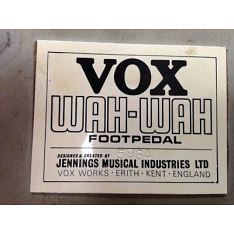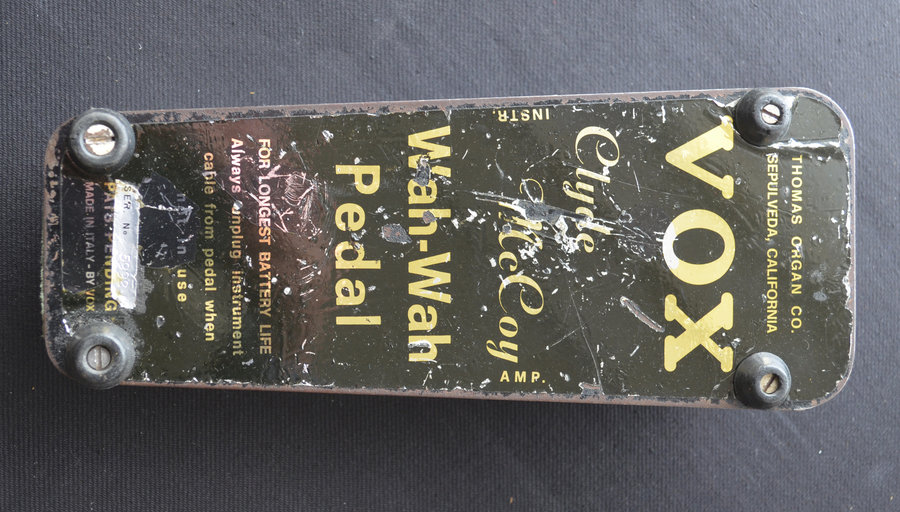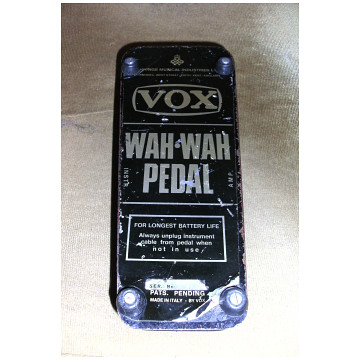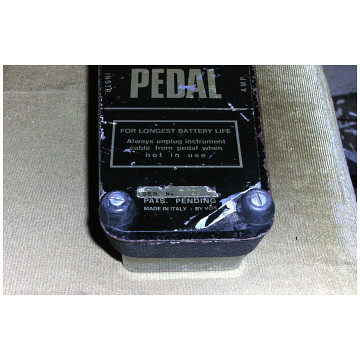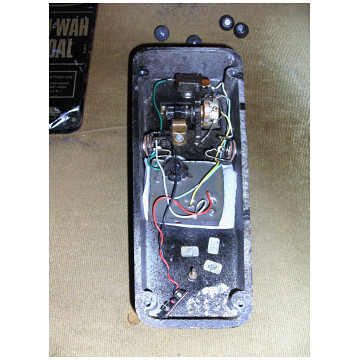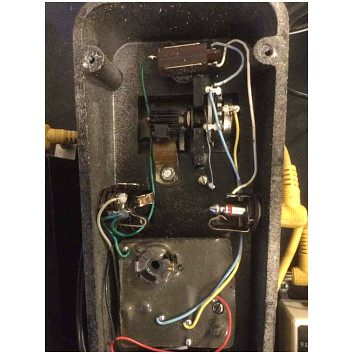The earliest Jennings Musical Industries Wah-Wah pedals: 1967 and early 1968
Over 2000 grey wah wah pedals were made at the Vox Works in Erith from around February/March 1967 to early 1968 - probably a 12 month period. Sales must have been good. Naturally we do not know in finite terms how many survive, but from those that do the changes that that took place in the course of production can be charted reasonably well. Some of the phases - the introduction of new types of component, for instance - overlap, others are more distinct. The examples below give an overview.
The page has benefitted hugely from the advice and findings of Stu Castledine. His website is here. Errors that remain are my own. Do let me know of new pedals, things to be corrected, and so on at this address.
There is a new page on documents here.
Dick Denney at the Frankfurt Trade Fair, 26th February to 2nd March 1967. Published in the music trade press March 1967. For more on the Fair, see this page on the Vox AC100 website.The heralded announcement was that Thomas would take over the distribution of its own organs in the UK from JMI. The arrangement for JMI to distribute Thomas was first made in Chicago at the NAMM show of 1963.
Vox retail pricelist, April 1967
"Beat Instrumental", vol. 48, April 1967, p. 24, the new effect connected explicity with the mid-range-boost of the new Vox solid state amplifiers. For further notices of Vox equipment in "Beat Instrumental", see this page.
Beat Instrumental number 49. May 1967
Entry for the Vox Wah-Wah pedal in the Solid State brochure of Summer 1967. Note that this pedal, along with the one pictured above (probably the same), has a clear pre-production, or at least early production "Wah Wah" label on its side - no curved loop under the jack socket.
A brief account of the development of the Wah Wah pedal in the States - well covered in other sources - will be given here shortly - simply to give some background to the pedals issued by Jennings in 1967. In the meantime, see for instance, this New York Times page.
The advert above, from "Beat Instrumental Magazine", April 1967, is one of the earliest public indications of JMI's move to release a pedal of its own. The retail pricelist will not have been widely circulated.
OS/158 - the JMI circuit diagram for the electronics. Note the original intention to provide a battery switch. Further analyis of the circuit in relation to the "Preliminary Schematic" of April 1967 published by Thomas Organ in the Accessories Service Manual will be given in due course.
The first Jennings wah-wahs are often called "greys" - the colour of their casings. Serial numbers apparently began at 5000 and run on certainly to the low 7000s. The rather bonkers claim that there were "only 100 made" probably stems from dealers or "gurus" bigging things up. These pedals are not prototypes, nor are they from 1966 as is sometimes said.
By the time we come to serial numbers in the 7500s - 7800s, we have a model of a different sort. The pedal externally looks like an American model, but the plate on the bottom has the symbol of the Queen's Award for Industry, the name of "Jennings Musical Industries", and lower down "Made in Italy for VOX". Serial numbers are printed on a paper sticker.
Components
At first, the 4uf capacitor employed in the circuit was a yellow Lemco - also used extensively in the preamps of the new Vox solid state amplifiers. Visible date codes on the caps in the pedals are "YB" = February 1967, and "YF" = June 1967. Thereafter, or apparently thereafter, one finds green TCC (Telegraph Condenser Company) 4uf caps. Date codes are "YE" = May 1967, and "YF" = June '67. Later Lemcos were used again - date codes "YJ" and "YL" = September and November '67.
Transistors are at first BC150, then 2N3707. The date code on the majority of the 2N3707s is "716" which indicates the 16th week of 1967 = April 1967. We also have "743" = the 43rd week of the year = October 1967. Assembly of pedals with late '67 component codes is likely to have taken place early in 1968.
Component date codes are necessarily simply termini post quem - "dates after which". Weeks or months could elapse between the manufacture of the component and its being picked off the stockroom shelf at the Vox Works in Erith for incorporation in a unit.
Serial numbers are at first hand-stamped on the white traffolyte label on the underside of the pedal. Later they were stamped on the base plate. See no. 6012 below.
It may be that there were two sets of benchs in the workroom or workrooms - one that stopped putting on traffolyte plaques at around serial number 6000, another that continued to around number 6300 (highest so far 6273).
Number 6251 survives with its original box - entry here - a wonderful thing. Below, a growing register of pedals:
Earliest
Yellow Lemco capacitors, BC150 transistors (as indicated in circuit diagram OS/158, above), glooped boards to prevent discovery of the circuit. White traffolyte plaques with stamped serial numbers on the underside.
The grey earth wiring on the pot and jacks, and the brown earth wires from the board are separated. Input wires are yellow; output white. The wire going to the pot wiper is green.
Serial number 5063
Bought at Gamlin Pianos in Cardiff in 1967. Thanks to Phil for the pictures.
Serial number 5074
Box and pedal sold recently. No shots of the interior (electronics). Pictures show however that the switch is a later replacement. A non-standard transfer is present on the pedal's side - possibly the same as on serial number 5063 above. The box is certainly original.
Serial number 5182
A nice early pedal recently sold on ebay.de. The electronics are concealed by rubber solution. The applied logo on the sides is standard white. The pot code is "YF" = June 1967. The transistors are dabbed with white to indicate that they have been tested.
Serial number 5130
Known to exist - formerly in the USA, now in Russia. Thanks to Mike for the info.
Serial number 5351
Serial number 5524
The circuit board is glooped to prevent rivals from copying the circuit. Visible date codes: one of the 2N3707 transistors has "716" = 16th week of 1967, and the potentiometer has "YF" = June 1967. The presence of 2N3707s instead of BC150s indicates that this pedal was in some respects "transitional" - see the section on "Second Format" further down this page. An extra jack has been added later on the input side. Thanks to Martin for the pictures.
Serial number 5527
Advertised currently. Further pictures are on "Vintage and Rare". The component board has been glooped in rubber solution to prevent discovery of the circuit. The original BC150 transistors are present and correct.
Serial number 5654
Excellent condition. Probably one of the last wahs to be issued with a glooped component board. The potentiometer has the date code "YF" = June 1967 for its manufacture; the visible 2N3707 transistor has "716" = 16th week 1967. In general form, serial number 5654 is similar to 5524 (above). Thanks to Niels for the pictures.
Serial number unknown
The circuit board glooped, as above. The transistors, the tops marked with white dots of paint to indicated that they have been tested, are BC150.
Second format
Yellow Lemco capacitors (date codes "YB" to "YF"), 2N3707 transistors, un-glooped circuit boards. Note that serial number 5524 (above) is in some respects transitional , having a glooped board but 2N3707 transistors. White traffolyte plaques with stamped serial numbers on the underside were used through to the low 6000s.
The yellow and white jack wires remain, but now the input to the board is orange, output wires are grey, earth wires red, and the wiper wire blue (often a lighter blue earlier on). The brown earth wires are twisted together.
Serial number 5716
Serial number 5855
The yellow Lemco 4uf capacitor has the date code "YF" = June 1967.
Serial number 5876
The 2N3707 transistor at board end has the date code "716" = April 1967.
Serial number 5879
The yellow Lemco 4uf capacitor has the date code "YF" = June 1967. The transistor at board end has been replaced.
Serial number 5932
See further down this page - "Third Format"
Serial number 5964
2N3707 date codes are "716" = April 1967. The code on the Lemco capacitor is either "YE" or "YF" = May or June 1967. Two sets of pictures. The first three from the sale on ebay c. 2011, the others from this page.
Serial number 5984
See further down this page - "Third Format"
Serial number 5985
Surfaced in Denmark, now in the UK. A good clean example. The transistors are "716" = April 1967, the yellow Lemco capacitor and pot "YF" = June 1967.
Serial number 6065
Similar to the pedals above and below - Lemco capacitor date code "YF" = June 1967; the 2N3707 transistor marked "TI 716" = 16th week of 1967.
Serial number 6251
Still with its original box. Lemco capacitor code "YF", transistor code "716". Thanks to Raphael for the pictures.
Serial number 6258
The yellow Lemco capacitor has the date code "YB" = February 1967. Pictures from this page.
Serial number 6273
White traffolyte plaque for the serial number.
Serial number 6280
Good condition overall. The inductor has been renewed. Visible date codes: - Lemco capacitor "YF" = June 1967; the 2N3707 transistor marked "TI 716" = 16th week of 1967.
Serial number 6330
Still the yellow Lemco capacitor, though no date is visible.
Serial number 6358
Serial number stamped on the metal base, no plaque. The pot has date code "YF" = June 1967, and the 2N3707 transistor "716" = 16th week of '67.
Serial number 6368
Similar to the pedal above. Number stamped directly on the case. Yellow Lemco capacitor.
Serial number 6382
Yellow Lemco capacitor (presumably with date code "YF" = June 1967), and 2N3707 transistor with "716" = 16th week of '67. Thanks to Josh for the pictures and correction - the pedal had been mistakenly given as number 6192 on this page.
Third format
Green TCC capacitors, clear "Wah Wah" labels on the side, serial numbers always stamped on the metal base plate. Wiring as the second format.
Serial number 5932
Serial number stamped on the base plate. Clear WAH_WAH stickers. Although the wiring follows the earlier colour scheme, transistor date codes are 716 and 743, which last is October 1967.
Serial number 5984
The best example on this page, complete with its box and instruction sheet. As above, serial number stamped on the base plate. Clear WAH_WAH stickers. The green TCC capacitor has the date code "YF" = June 1967.
Serial number 6012
The transistor at board end has the date code "710" = 10th week (March) of 1967.
Serial number 6233
Reproduction Vox label printed on paper; "Wah-Wah" transfer may be a copy too; transistors renewed.
Serial number 6298
Serial number stamped on the metal base.
Serial number 6388
Serial number 6451
Note the date code on the green TCC capacitor: "YF" = June 1967.
NEW
Serial number 6460
Serial number unknown
Green TCC 4uf capacitor.
Serial number unknown
Green TCC 4uf capacitor. The 2N3707 transistor immediately above has the code TI 743 = which probably indicates the 43rd week (October) of 1967.
Latest format
Hardwired output cable. Some Lemco capacitors (date codes "YJ" and "YL"), others green TCC, clear "Wah Wah" labels on the side, serial numbers stamped on the metal of the bottom plate.
Hard-wired output cable and green earth wires. White and yellow wires occasionally on the input jack. Red sleeves on the buss wire from the 470K resistor.
Serial number 6847
The pot has the code "YL" = November 1967.
NEW
Serial number 6871
Lemco capacitor with "YJ" = September 1967. The "N3707 transistor has the date code "745" = 45th week of 1967 for its manufacture. Note the (original) mis-stamping of the number.
Serial number 6943
A Wah pedal turned into a volume pedal, electronics removed.
Serial number 6988
Lemco capacitor code "YJ" = September 1967. Output hard-wired with jack plug on cable. Transistor date code "745". The pot has been replaced.
Serial number 7122
This pedal is more "third format" in character - green TCC capacitor, white "Wah-Wah" transfer on the side, two jack plugs instead of a hard-wired output cable. The orginal Arrow switch and its fixing ring seems to be gone.
Serial number 7181
An unusual instance of clear (rather than white) logos applied on the sides of the pedal. The TCC capacitor appears to have the date code "YF" = June 1967. The mustard capacitor (from 1972) is a later replacement.
Serial number 7184
Pictures to follow soon.
Serial number unknown
Red sleeves on the solid buss wire. Not quite possible to see the date code of the Lemco capacitor. The transistor at end of board has the code "TI 743" or "745" - either 43rd or 45th week (October) of 1967. Some rewiring evident (and new jack sockets).
Serial number unknown
Red sleeves on the solid buss wire.
ITALIAN MADE
QUEEN'S AWARD SYMBOL and PEDALS FOR THE ITALIAN MARKET
Note that one also finds a circuit board potted with resin in certain batches of Clyde McCoy "script" wahs (so-called to distinguish them from the pedals with an inset picture of Clyde McCoy) made in Italy for Thomas Organ, the company that owned, or at least laid claim to, the Vox name in the USA.
To date, Clyde "script" wahs with resin-potted boards have only turned up in Italy - ie. they seem not to have been shipped to the States. For more, see this page.
In Italy, the pedals were distributed by Comusik, which handled the Vox solid state line, imported from England. The Comusik brochure is on this page. The wah-wah pedal pictured on the Gyrotone and keyboard page is of the Thomas Organ rather than the English ("grey") type.
Wah nominally made for Thomas Organ but sold locally in Italy. Serial number 5992. No red inspection mark on the inductor. This pedal came from Rome.
Above, a Clyde McCoy "script" Wah made in Italy for Thomas Organ.
THE QUEEN'S AWARD VERSION
Serial number 7685
Thanks to Richard for the pictures.
Serial number 7729
Currently in the UK. The serial number sticker is much the same as those on pedals made for the Italian market. The sticker on serial number 7857 (below). is of a different type. Thanks to Nick for the pictures.
Serial number 7857
The component board is "potted" with grey resin to prevent discovery of the circuit. Thanks to Sean (AKA Doc Holliday) for kind permission to use his pictures here.
Serial number unknown - currently in the UK
Nothing altered. As above, the component board potted with grey resin. Potentiometer made by ICAR, wafer switch by Arrow (England). Thanks to Dave for the pictures.
Serial number unknown
Clearly different from the ones above. But only this photo for the time being.








































































